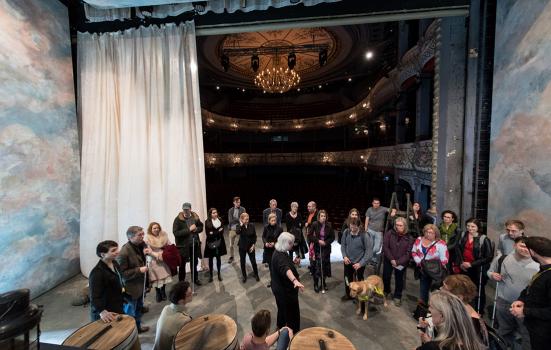What has been the impact of the coronavirus pandemic on those who are blind or have low levels of vision? And how can cultural venues meet their needs when the doors open again? Matthew Cock asked some searching questions.

Manuel Harlan
Surveys show that many people are concerned about the reopening of their favourite arts venues. Will they be safe? What will the experience be like? But for blind and visually impaired people, those concerns are magnified. Such will be the difficulties that they may give cultural experiences outside the home a miss until a vaccine has been developed and they can feel safe and secure in crowded places.
A group of VocalEyes trustees and user panel members, all of whom are frequent visitors to museums, heritage sites and theatres, told me about their hopes and fears, and what will need to happen to ease their return to the cultural experiences they love.
How can arts venues support blind and visually impaired visitors when they begin to re-open?
Venues will need to be very aware of the needs of blind and visually impaired visitors, and indeed, those of any disabled visitors. Ideally, they will provide guidance on their website that's easy to find, and have people answering the phone who are fully briefed, so the caller knows what to expect, or even if it's worth going at all.
For a blind person with a very low level of sight, practical assistance is essential, whether for navigating their way round a gallery, identifying key parts of a heritage site or simply finding a seat in a theatre. If they are accompanied by a family member or trusted guide, then the institution should accept that these two people can be close together, while keeping their distance from other visitors and staff. For those that live alone, or would usually visit without a companion, venues will have to make staff with PPE available to guide them.
Practical support has been made even more necessary since the start of the pandemic, with a proliferation of visual signage about social distancing (distance markers, capacity restrictions and other changes to normal practices) and temporary changes to routes both on the streets and indoors. For those with some sight, and those able to move around independently, a venue should make any temporary signs or floor markings large, clear, and high contrast. Floor markings should also be tactile for cane users as well.
Social distancing has brought significant stress to many people with sight loss. There are reports in the press about blind people being shouted at in the streets for not abiding by social distancing rules. One of VocalEyes’ own trustees was subject to an aggressive confrontation over social distancing by a member of the public, and has experienced people breaking distancing rules with un-signalled and un-asked for physical intervention, exposing her to risk without her agreement.
The message for sighted people comes through strong: the onus is on them to be alert to the fact that someone has a visual impairment, and either to keep their own distance, or if necessary, engage with empathetic, descriptive and above all, helpful conversation. Many blind and partially sighted people are doing their best to make themselves more visible, wearing hi-vis sashes or carrying and using their cane more prominently than usual.
What about getting to a venue?
A major barrier is getting to a cultural venue in the first place, given that public transport is effectively a no-go for most people with a visual impairment at the moment. Social distancing is too often compromised, and as the rules on this soften, local streets are becoming increasingly crowded. These concerns have a basis in hard statistics. Using measurements from Ordnance Survey, Esri UK has mapped and analysed pavement widths in Great Britain: only 30% are at least 3 metres wide, 36% are between 2 and 3 metres and 34% are less than 2 metres wide.
In London, the usual excellent guiding and assistance support provided by Transport for London staff for blind and partially sighted people is on hold due to social distancing and staff safety. Due to concerns about the higher risk of infection in enclosed spaces like trains and buses where people are in close proximity for extended periods, some haven’t used public transport for nearly three months and feel that life won’t look that much different from lockdown for the next 3-6 months.
Some will be wondering whether the travel will be worth the effort if limited capacity involves long queues or booking in advance, ending up in a wasted journey if the queue is so long that there will be no time to linger inside a museum or gallery.
Will there be audio-described tours and handling sessions at museums and heritage sites?
If visitor numbers are limited so that social distancing can be maintained it should be possible to run audio-described tours, but handling sessions seem to be out of the question, as it wouldn't be safe to pass items from person to person.
Museums could develop descriptive video tours online that could be watched before or after, or even in place of a physical tour if museums are not comfortable providing one. Museum tours online in recent weeks, include the British Museum Live events (Pompeii Live and Vikings Live), which have wonderful close-up views of the exhibits and the narration is sometimes quite descriptive.
What about the return to theatres?
It is difficult to conceive how social distancing can be achieved for sighted or visually impaired patrons within conventional theatre structures, while still providing enough spaces to make productions economically viable, and the prospects for theatre in the immediate post-Covid era are dismal. One solution might be for theatres to take their productions out of the conventional venue, and present them in alternative community settings - such as local parks, large churches, industrial buildings, sporting facilities, carparks etc - where people with visual impairment would feel more confident that social distancing could be maintained. This would also present a welcome challenge to producers and performers in terms of 'democratising' theatrical performances.
What do you think will happen to audio-described performances and touch tours?
For the safety of participants, actors and other theatre staff, no one expects touch tours to happen – even with very strict hygiene measures in place – until a vaccine is widely available. As a substitute, the introductory notes could be extended or a video tour could be made available online before the show, with close-up views of some of the costumes, props, sets, etc, with very descriptive narration so that those who can't see it can still benefit from it.
The audio description of the performance itself could go ahead, but there would be challenges to ensure that they were safe and free of infection as so many people come into contact with the headsets. A potential mitigator would be for people to use an app on their own phone, or a downloaded recording of the audio description, but this would make it less entwined with the live performance.
There are concerns that, in the economically difficult times that they will be facing, theatres may not be willing to commit the small amount of extra funds for audio description, despite requirements of the Equality Act, or their commitments to equality and diversity. Extra work communicating with audiences through VocalEyes and venues’ own access lists is needed.
Matthew Cock is CEO of access organisation VocalEyes
https://vocaleyes.co.uk/
Read more online about what blind and visually impaired people think about the culture they have been engaging with online, how accessible it has been and whether there should be more of it in future.
VocalEyes’ weekly email newsletter and blog post The Interval rounds up the best of accessible cultural content available online. If you want VocalEyes to help make your production (live or digital) accessible to blind and partially sighted people, or for us to promote accessible events or content to our followers and subscribers, contact enquiries@vocaleyes.co.uk or twitter.com/VocalEyesAD.




